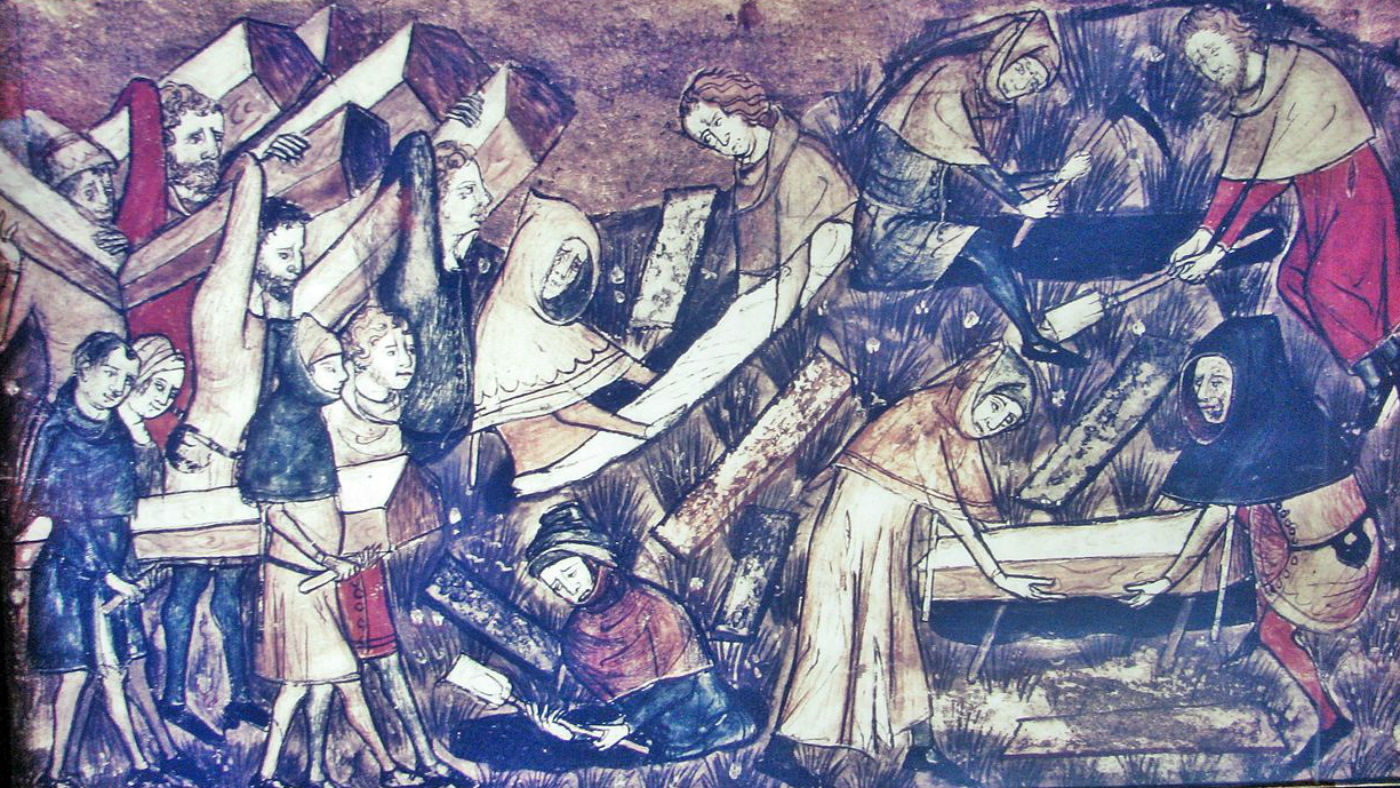The Black Death: what was it, how did it start and what is its legacy?
New evidence suggests deadly bubonic plague that wiped out half of Europe in 14th Century was triggered by a volcanic eruption

Scientists believe they have finally uncovered what triggered the deadly plague that wiped out over half the medieval population of Europe.
Researchers from the University of Cambridge and the Leibniz Institute for the History and Culture of Eastern Europe in Leipzig said that “clues contained in tree rings” have “identified mid-14th-century volcanic activity as the first domino to fall in a sequence that led to the devastation of the Black Death in Europe”.
Their research suggests an eruption, or series of eruptions, around 1345 caused extreme drops in temperature and led to poor harvests. To avert famine, Italian city states were forced to import grain across the Black Sea, bringing with it the plague-carrying fleas that brought the disease to Europe.
The Week
Escape your echo chamber. Get the facts behind the news, plus analysis from multiple perspectives.

Sign up for The Week's Free Newsletters
From our morning news briefing to a weekly Good News Newsletter, get the best of The Week delivered directly to your inbox.
From our morning news briefing to a weekly Good News Newsletter, get the best of The Week delivered directly to your inbox.
What was the Black Death?
The Black Death, caused by the spread of the yersinia pestis bacteria by rats, was a devastating pandemic that first struck Europe in the mid-1300s, when it's estimated to have killed up to two-thirds of the population. Its name is a "reference to the gangrenous blackening and death of body parts, such as the fingers and toes, that can happen with the illness", said the BBC.
There are three different types of plague: bubonic, pneumonic and septicaemic. "If left untreated, the bubonic form has a 30% to 60% fatality rate and the pneumonic form is almost always fatal. Both bubonic and pneumonic plague can develop into a life-threatening infection of the blood called septicaemia," said an Oxford University briefing for the Oxford Vaccine Group.
Where did it come from?
A popular theory was that the Black Death originated in China, but most experts now believe it started in Central Asia.
In 2022, an international team of researchers published analysis of DNA from human remains in two cemeteries in the Tian Shan region of what is now Kyrgyzstan that saw a surge of burials in 1338 and 1339. Some tombs were inscribed with the word “pestilence” in a Turkic language.
A free daily email with the biggest news stories of the day – and the best features from TheWeek.com
“The ancient strains from Kyrgyzstan are positioned exactly at the node of this massive diversification event,” lead author Maria Spyrou, from the University of Tübingen, said. “In other words, we found the Black Death’s source strain and we even know its exact date: 1338.”
Now the University of Cambridge/Leibniz Institute researchers “have filled in a missing part of the puzzle” about the “precise sequence of events that brought the disease to Europe”, said the BBC.
After trade ships brought the plague from Kyrgyzstan, the disease spread further “via the Silk Road” as other traders moved goods on, said The Telegraph.
It arrived on the British Isles in 1348, travelling on boat from the then English (now French) province of Gascony, and the speed with which it spread has led scientists from Public Health England's Porton Down science labs to argue that it began to spread by air, making "its way into the lungs through coughs and sneezes", said History.
Between 1346 and 1353, the plague destroyed a higher proportion of the population than any other single known event. "The living were scarcely sufficient to bury the dead," said History Extra.
How did it end?
Most theories suggest that it was the imposition of quarantine measures that ensured the end of the Black Death. People would remain in their homes and only leave when it was necessary, to avoid becoming infected, while wealthier individuals would leave densely populated areas to live in greater isolation.
Improvements in personal hygiene are also thought to have played a part, alongside the introduction of cremations rather than burials, due to the sheer number of bodies.
In subsequent years, further plague epidemics hit the UK, with the worst outbreak since the Black Death beginning in 1665, when London lost around 15% of its population. It's commonly believed that it was finally wiped out by the Great Fire of London in 1066 – a good story, but sadly not true, said the London Museum. In reality, the number of deaths had been in decline before the fire, and continued after it. "We're still unsure why the plague did not return to our shores after it faded out in the 1670s, but it wasn’t due to London’s terrible fire," the museum's site said.
What is the Black Death's legacy?
"A historical turning point, as well as a vast human tragedy, the Black Death of 1346-53 is unparalleled in human history," said Ole J. Benedictow at History Today.
It would take 200 years before Europe alone was able to replenish its population to pre-plague numbers, while the world also suffered monumental setbacks in terms of labour, art, culture and the economy.
There is also an argument that some people today are susceptible to certain diseases because of DNA passed down the generation by plague survivors, said Fortune in 2022, citing a study that found that "genetic variants identified as protective against the plague are associated with Crohn's disease, rheumatoid arthritis and lupus".
However, in 2024, a team from the University of Cambridge said their own studies of skeletal DNA from people living before and after the plague in Cambridgeshire could find no "substantial evidence that the Black Death has shaped the genetic make-up of surviving individuals", said scientific news site Technology Networks.
Where is the Black Death found today?
While Britain has been plague-free for centuries, it can still be found on all continents except Oceana as an animal disease, and there continues to be a risk that it can transfer to humans, reported the WHO.
While epidemics have occurred in Asia and South America, most human cases since the 1990s have been in Africa. The three most endemic countries are the Democratic Republic of Congo, Peru and Madagascar, where cases of bubonic plague are reported nearly every year. There are about seven cases in the US each year, although only 14 deaths were recorded between 2000 and 2020.
In 2024, the WHO added the bacteria that causes the illness to its pathogen prioritisation watchlist of potential pandemic triggers.
Is there a cure?
At present, cases of bubonic plague can be treated with antibiotics, but worries about the potential emergence of an antibiotic-resistant strain of the Black Death superbug has led to calls for the UK to find a vaccine to add to its stockpile, The Telegraph reported in January.
Trials of a newly developed vaccine on healthy adults began in 2021, and results have now shown it to be safe and able to produce an immune response in humans, Professor Andrew Pollard, director of the Oxford Vaccine Group who led the study, told the paper.
As well as potentially saving lives, the development of the vaccine also “addresses broader challenges of managing re-emerging infectious diseases in a world increasingly interconnected by trade and travel”, Select Science said.


